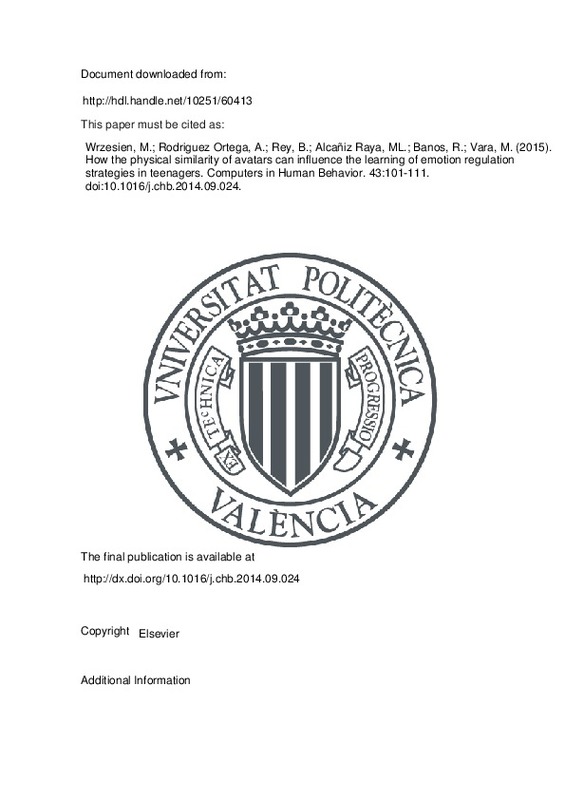JavaScript is disabled for your browser. Some features of this site may not work without it.
Buscar en RiuNet
Listar
Mi cuenta
Estadísticas
Ayuda RiuNet
Admin. UPV
How the physical similarity of avatars can influence the learning of emotion regulation strategies in teenagers
Mostrar el registro sencillo del ítem
Ficheros en el ítem
| dc.contributor.author | Wrzesien, Maja
|
es_ES |
| dc.contributor.author | Rodríguez Ortega, Alejandro
|
es_ES |
| dc.contributor.author | Rey, Beatriz
|
es_ES |
| dc.contributor.author | Alcañiz Raya, Mariano Luis
|
es_ES |
| dc.contributor.author | Banos, R.M.
|
es_ES |
| dc.contributor.author | Vara, M.D.
|
es_ES |
| dc.date.accessioned | 2016-02-01T10:47:00Z | |
| dc.date.available | 2016-02-01T10:47:00Z | |
| dc.date.issued | 2015-02 | |
| dc.identifier.issn | 0747-5632 | |
| dc.identifier.uri | http://hdl.handle.net/10251/60413 | |
| dc.description.abstract | The aim of this study is to evaluate the influence of the physical similarity of avatars with the user on emotion regulation strategy training. In this study twenty-four teenagers observed an avatar (either physically similar to the participant or neutral) that gets frustrated with his/her computer, after which he/she applies an emotion regulation strategy (slow breathing). The intensity of the emotional induction and regulation processes was measured using questionnaires and electroencephalogram data. The results show that observing an avatar that is physically similar to the participant has a significantly greater impact on emotional valence and arousal in participants and also induces emotional states that are significantly more intense than when observing a neutral avatar. The results seem to indicate significantly greater activation of specific brain regions that are related to these processes and greater identification with the avatar in terms of both subjective and objective measures in participants that observed an avatar that was physically similar to them. However, there were no significant differences in the sense of presence or the appeal (i.e., satisfaction) to participants regarding the virtual environment. The use of avatars in mental health applications is relatively new and its specific influence is still unknown. We consider this study to be a first step forward in better understanding the use of avatars in mental health applications for youth. This research brings new guidelines to the design of different types of applications in this field in order to achieve greater behavioral changes in youth. | es_ES |
| dc.language | Inglés | es_ES |
| dc.publisher | Elsevier | es_ES |
| dc.relation.ispartof | Computers in Human Behavior | es_ES |
| dc.rights | Reserva de todos los derechos | es_ES |
| dc.subject | Avatars, Virtual reality, Emotions regulation, Teenagers | es_ES |
| dc.subject | Avatars | es_ES |
| dc.subject | Virtual reality | es_ES |
| dc.subject | Emotions regulation | es_ES |
| dc.subject | Teenagers | es_ES |
| dc.subject.classification | EXPRESION GRAFICA EN LA INGENIERIA | es_ES |
| dc.title | How the physical similarity of avatars can influence the learning of emotion regulation strategies in teenagers | es_ES |
| dc.type | Artículo | es_ES |
| dc.identifier.doi | 10.1016/j.chb.2014.09.024 | |
| dc.rights.accessRights | Abierto | es_ES |
| dc.contributor.affiliation | Universitat Politècnica de València. Instituto Interuniversitario de Investigación en Bioingeniería y Tecnología Orientada al Ser Humano - Institut Interuniversitari d'Investigació en Bioenginyeria i Tecnologia Orientada a l'Ésser Humà | es_ES |
| dc.contributor.affiliation | Universitat Politècnica de València. Departamento de Ingeniería Gráfica - Departament d'Enginyeria Gràfica | es_ES |
| dc.description.bibliographicCitation | Wrzesien, M.; Rodriguez Ortega, A.; Rey, B.; Alcañiz Raya, ML.; Banos, R.; Vara, M. (2015). How the physical similarity of avatars can influence the learning of emotion regulation strategies in teenagers. Computers in Human Behavior. 43:101-111. doi:10.1016/j.chb.2014.09.024 | es_ES |
| dc.description.accrualMethod | S | es_ES |
| dc.relation.publisherversion | http://dx.doi.org/10.1016/j.chb.2014.09.024 | es_ES |
| dc.description.upvformatpinicio | 101 | es_ES |
| dc.description.upvformatpfin | 111 | es_ES |
| dc.type.version | info:eu-repo/semantics/publishedVersion | es_ES |
| dc.description.volume | 43 | es_ES |
| dc.relation.senia | 276823 | es_ES |







![[Cerrado]](/themes/UPV/images/candado.png)

